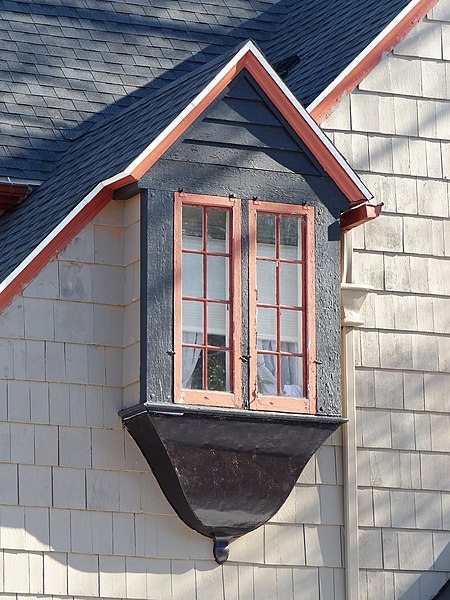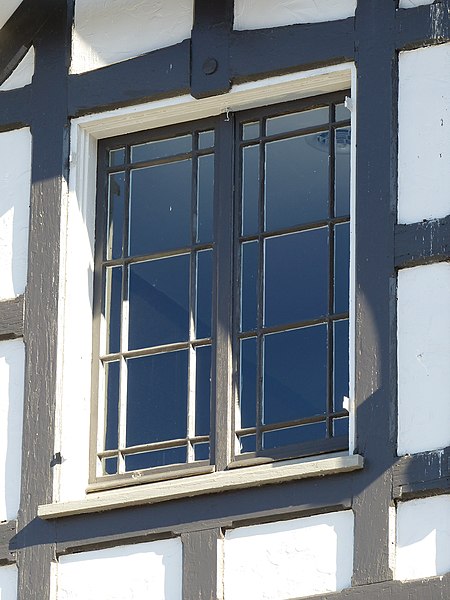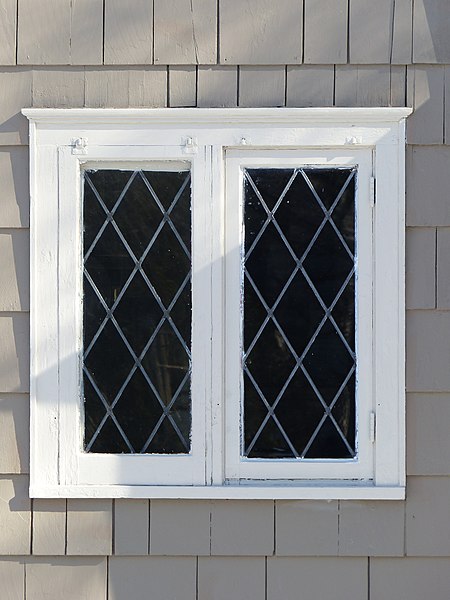History
A prominent window style utilized in many different architectural designs, casement windows have a rich history that goes back to the dawn of civilization. They have developed over the years.
Casement windows had its roots in the Middle Ages, when windows were often modest wall apertures with wooden shutters for light and air. These early windows had a straightforward design and no glass panes; instead, they used iron or wooden bars to deter intruders.
Larger glass panes were created during the European Renaissance thanks to improvements in glass-making methods, which made it possible to create windows that were more substantial and had better visibility. During this time, casement windows gained popularity as a better alternative to basic shutters and a more opulent and useful choice for homes and structures.
In England, casement windows gained popularity in the 17th century, especially in more substantial residences and structures. They were frequently used with other window styles, including mullioned windows, to make window openings larger and let in more light. During this time, casement windows were often composed of wood with relatively small glass panes because larger panes were expensive and difficult to manufacture.
Larger and more effective casement windows were created in the 18th and 19th centuries as a result of technological developments in glass production and woodworking. Larger glass panes and improved structural stability were made possible by the introduction of cast iron frames and sashes. Additionally, casement windows began to come with more sophisticated hardware, like sash locks and hinges, which increased their security and functionality.
With the development of new materials like vinyl and aluminum in the 20th century, casement windows continued to advance in terms of durability, energy efficiency, and minimal maintenance requirements. In addition to enhanced weatherstripping and energy-efficient glass, contemporary casement windows are more energy-efficient than earlier models.
Casement windows are still commonly employed in both residential and commercial structures today. They are renowned for their adaptability, making it possible for simple operation, great ventilation, and unhindered vistas. Casement windows can be made to order in a variety of materials, such as wood, aluminum, vinyl, and fiberglass, to match a variety of architectural styles and aesthetic preferences. They continue to be a preferred option for many architects and homeowners because of its usefulness, beauty, and historical attraction.
The beautiful thing about windows is that they all seem to provide the same function. They are majorly for ventilation, sunlight, delivering energy efficiency, and a nice spot to sit and enjoy the outdoor view. Well, not egress windows. These windows are for emergencies and have dimensions that ruin their essence if not measured accurately.
Egress windows serve as exit windows in case of emergencies and are mandatory for every bedroom in Canadian homes. When the need for an emergency exit arises, you’d need a smooth exit. So, the type of window you install there matters a lot.
We have made a deep analysis and concluded that Ecoline Casement Windows are the best if you need this window style. But are casements the best to install, or you need to consider other options for egress? Let’s find out!
What are casement windows?
Casement is a window type with one or two hinges attached to the sides of its frame and a hand crank that allows you to open it outwards or inwards. They work just like a swinging door. This window type comes with a lock embedded in the frame for security purposes. Casement windows do great alone and work as a pair too.
Types of Casement Windows
Casement windows come in three major variants. Homeowners can choose what type they want, depending on their taste and budget. Here they are:
1. Single Frame Casement Windows
The most commonly installed casement window is the single frame casement window. It consists of a single frame and panels of glass in this frame. The panels of glass can be opened outwardly or inwardly and are usually separated by wooden strips. Most homeowners find it appealing and quite affordable.
2. Double Frame Casement Windows
If you crave a little bit of French fitting in your apartment, the double frame casement windows are what you need. Unlike the single frame casement windows, you get two windows hinged at the sides. Both windows meet in the middle when swung open.
The double frame casement window is also called the French casement window, as they operate like French doors. You get an uninterrupted view of your neighbourhood with this casement. However, installation is relatively expensive.
3. Push-out Casement Windows
The1 push-out casement window is a combination of both the single frame and French casement. It features a handle for operation instead of a crank. The push-out casement is the best for security purposes, as it features a multi-point locking system.
The table below represents the typical price range for casement windows for different locations within your home.
| Location | Casement window |
| Basement | $535 – $1,022 |
| Bathroom | $446 – $1,032 |
| Bedroom | $444 – $1193 |
| Bonus room | $676 – $1134 |
| Dining room | $550 – $1348 |
| Family room | $605 – $1999 |
| Foyer | $858 – $1999 |
| Front | $583 – $1014 |
| Garage | n\a |
| Kitchen | $329 – $1356 |
| Living room | $484 – $1614 |
| Master bedroom | $545 – $1304 |
| Nook | $549 – $1149 |
Source: Ecoline Casement Windows
4. French Casement Windows
French casement windows, also referred to as double casement windows, have two sashes that open outward and are hinged on the sides. French casement windows, unlike single casement windows, lack a vertical mullion (a vertical divider between the sashes), allowing for optimal ventilation and an obstruction-free view.
5. Top-Hung Casement Window
The top-hung casement window, also referred to as an awning window, is hinged at the top and opens outward from the bottom. Since it can be opened partially from the bottom while still acting as a water-resistant barrier, this particular style of casement window is intended to enable ventilation even when it is raining.
6. Bottom-Hung Casement Window
The bottom-hung casement window, also referred to as a hopper window, is hinged at the bottom and opens inward from the top. This particular style of casement window is frequently utilized in basements or other small spaces because it provides ventilation while preserving privacy and security.
7. Combination Casement Window
Combination casement windows generate unique window units that meet certain architectural and functional requirements by combining several window types, such as casement windows with fixed windows or other working windows. For ventilation and aesthetic purposes, a combination casement window, for instance, might have two casement windows flanking a fixed picture window in the middle.
Pros and Cons of Casement Windows
Before installing a casement window, here are some benefits and downsides to consider;
Pros
- Great for Ventilation
Casement windows are designed to let you open the window pane completely. This way, you give more passage to the wind, as there are no obstructions.
- Energy Efficient
Controlling indoor temperature is easier with casement windows. They seal perfectly and help you regulate the temperature in your apartment. Outdoor air will not easily get in, as it features a sash that creates an airtight seal.
- Improved Security
With its lock embedded in its frame, breaking in would be a difficult task. However, breaking in isn’t impossible, but it gives burglars and strangers out for a long while.
- Unrestricted View
You get to enjoy the most out of the outdoor view of your apartment. Casement windows allow you to swing open their window panes, keeping all obstructions out of the way.
Cons
While the casement window seems like a perfect window style, it comes with a few downsides that you may or may not be able to condone.
- Size restrictions
Casement windows come in standard sizes, leaving you with little or no option to access your preferred size. Mounting air condition units on them is also impossible since they can be swung outwardly.
- Pricy
These windows are more expensive than other window styles. The only relatively cheap option is the single frame casement window.
Why Casement Style Window is the Perfect Fit for Egress
The casement-style window has more functions than just energy efficiency and improved ventilation. It is perfectly suitable for egress. Its features make it possible for an emergency exit without having to break it down. Here are two main reasons why the casement style window works best for Egress:
Crank Operation
Unlike the sliding style windows, the casement style is easier to operate. The crank operation features make it easy to swing your windows open in the case of emergencies. All you have to do is lift the latch and crank clockwise. This process can be done quickly when under pressure and without consuming a lot of energy. The good thing is: kids can also learn to operate casement-style windows too.
Opening Degree
Casement windows can be opened completely without obstruction. While this feature is usually associated with ventilation, many homeowners are oblivious of how this can come in handy when there’s a fire outbreak. Casement windows can open to a full 90 degrees, giving you all the space you need to fit in. awning windows only open at 40 degrees; an exit will be difficult.
Older Homes May Not Have Egress Windows
New homes must comply with codes and include adequate egress windows in the basement and bedrooms. Open your bedroom windows completely, get a tape measure, and check to see if the opening complies with current egress regulations if you reside in an older, “pre-owned” property. To establish if the opening is the required 5.7 square, multiply the width by the height. 821 sq. feet, or ft. in.
Some older homes were constructed before any egress window specifications existed. When the egress window net free opening size was only 4.3 sq, much more dwellings were constructed. ft. But even more recent homes frequently lack enough exit windows. Attics and basements were frequently lawfully turned into family rooms or offices that didn’t need egress windows before being later transformed into bedrooms that do. Without the necessary escape window and without the inspectors’ knowledge, adding beds to basements might result in a dangerous underground fire trap. Homeowners frequently unintentionally switch out huge egress windows for smaller, non-egress ones when upgrading. Additionally, while most inspectors will insist that escape windows be constructed when bedrooms are renovated or added on, they won’t always order that windows in already-existing bedrooms be increased to egress size because it would be too challenging to keep an eye on every situation.
Egress windows are essential life-saving equipment whether they are required or not. Include a window with an egress dimension if there is even the slightest chance that a space could one day serve as a bedroom.
Extra Challenges for Basements
Egress windows in the basement pose an additional difficulty. There are specifications for the window well that surrounds the bedroom window in addition to those for height, width, and total square footage.
Wells in windows must:
- Permit the opening of the rescue window to fully open.
- Give 9 sq. ft. of “floor area,” with a 36-inch minimum both in length and width.
- If the window well depth is greater than 44 inches, have a permanently installed ladder or set of steps for exiting the window. At least 12 inches must be on the ladder. Project no less than three inches wide. It cannot be blocked by an open window or encroach more than 6 inches into the appropriate window well measurements. You can construct steps along one side of the window well if it is made of modular concrete blocks or timbers, which eliminates the need for a ladder. Do you want to conceal it? Learn to make a window well cover yourself.
We’re still not done. Inspectors and firefighters prefer at least 36 inches if an egress window is situated beneath a deck or porch. They much prefer 60 in between the top of the window well and the bottom of the deck or porch joists. If your egress opening’s bottom measurement is greater than 44 in. Some inspectors will let you make up the difference with a permanently installed step when measuring from the basement floor.
This is more complicated than it seems. Basement egress window installation is difficult. You need to dig a sizable hole, remove concrete by cutting through it, put in a sizable window and window well, keep the basement walls dry, and somehow make the whole thing seem beautiful when you’re done. Even though it’s a major undertaking, the family whose flaming television prevented them from leaving the basement will tell you how grateful they were to have an escape window.
Installing it the Right Way
Casement windows are to meet egress requirements when considered for use. By law, it is expected that the interior dimension of the operable part of the window should be at least 15 inches in length and a minimum of 3.77 square feet in total.
In cases where your window size doesn’t meet the egress standards, you will be looking into expanding the window opening. To do this, some part of the wall needs to be cut. Hence, hiring a professional from a reputable company is essential. This company must seek permission from local authorities and get the right permits before commencement.
Conclusion
Knowing your house is emergency-proof is a soothing relief. Though the whole process might be a little bit overwhelming, especially when you have to expand your wall – but your safety is worth it. Remember, having a reputable professional to get the job done keeps you out of trouble.



